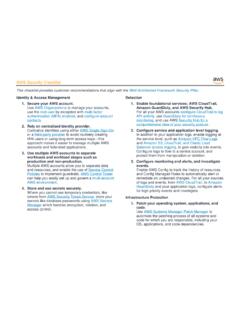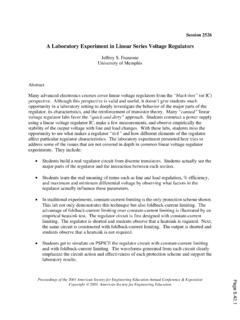Transcription of Mastering the game of Go with deep neural networks and ...
1 484 | NATURE | VOL 529 | 28 JANUARY 2016 the game of Go with deep neural networks and tree searchDavid Silver1*, Aja Huang1*, Chris J. Maddison1, Arthur Guez1, Laurent Sifre1, George van den Driessche1, Julian Schrittwieser1, Ioannis Antonoglou1, Veda Panneershelvam1, Marc Lanctot1, Sander Dieleman1, Dominik Grewe1, John Nham2, Nal Kalchbrenner1, Ilya Sutskever2, Timothy Lillicrap1, Madeleine Leach1, Koray Kavukcuoglu1, Thore Graepel1 & Demis Hassabis1 All games of perfect information have an optimal value function, v*(s), which determines the outcome of the game, from every board position or state s, under perfect play by all players. These games may be solved by recursively computing the optimal value function in a search tree containing approximately bd possible sequences of moves, where b is the game s breadth (number of legal moves per position) and d is its depth (game length).
2 In large games, such as chess (b 35, d 80)1 and especially Go (b 250, d 150)1, exhaustive search is infeasible2,3, but the effective search space can be reduced by two general principles. First, the depth of the search may be reduced by position evaluation: truncating the search tree at state s and replacing the subtree below s by an approximate value function v(s) v*(s) that predicts the outcome from state s. This approach has led to superhuman performance in chess4, checkers5 and othello6, but it was believed to be intractable in Go due to the complexity of the game7. Second, the breadth of the search may be reduced by sampling actions from a policy p(a|s) that is a prob- ability distribution over possible moves a in position s. For example, Monte Carlo rollouts8 search to maximum depth without branching at all, by sampling long sequences of actions for both players from a policy p.
3 Averaging over such rollouts can provide an effective position evaluation, achieving superhuman performance in backgammon8 and Scrabble9, and weak amateur level play in Carlo tree search (MCTS)11,12 uses Monte Carlo rollouts to estimate the value of each state in a search tree. As more simu-lations are executed, the search tree grows larger and the relevant values become more accurate. The policy used to select actions during search is also improved over time, by selecting children with higher values. Asymptotically, this policy converges to optimal play, and the evaluations converge to the optimal value function12. The strongest current Go programs are based on MCTS, enhanced by policies that are trained to predict human expert moves13. These policies are used to narrow the search to a beam of high-probability actions, and to sample actions during rollouts.
4 This approach has achieved strong amateur play13 15. However, prior work has been limited to shallow policies13 15 or value functions16 based on a linear combination of input , deep convolutional neural networks have achieved unprec-edented performance in visual domains: for example, image classifica-tion17, face recognition18, and playing Atari games19. They use many layers of neurons, each arranged in overlapping tiles, to construct increasingly abstract, localized representations of an image20. We employ a similar architecture for the game of Go. We pass in the board position as a 19 19 image and use convolutional layers to construct a representation of the position. We use these neural networks to reduce the effective depth and breadth of the search tree: evaluating positions using a value network, and sampling actions using a policy train the neural networks using a pipeline consisting of several stages of machine learning (Fig.)
5 1). We begin by training a supervised learning (SL) policy network p directly from expert human moves. This provides fast, efficient learning updates with immediate feedback and high-quality gradients. Similar to prior work13,15, we also train a fast policy p that can rapidly sample actions during rollouts. Next, we train a reinforcement learning (RL) policy network p that improves the SL policy network by optimizing the final outcome of games of self-play. This adjusts the policy towards the correct goal of winning games, rather than maximizing predictive accuracy. Finally, we train a value network v that predicts the winner of games played by the RL policy network against itself. Our program AlphaGo efficiently combines the policy and value networks with learning of policy networksFor the first stage of the training pipeline, we build on prior work on predicting expert moves in the game of Go using supervised learning13,21 24.
6 The SL policy network p (a | s) alternates between con-volutional layers with weights , and rectifier nonlinearities. A final soft-max layer outputs a probability distribution over all legal moves a. The input s to the policy network is a simple representation of the board state (see Extended Data Table 2). The policy network is trained on randomly The game of Go has long been viewed as the most challenging of classic games for artificial intelligence owing to its enormous search space and the difficulty of evaluating board positions and moves. Here we introduce a new approach to computer Go that uses value networks to evaluate board positions and policy networks to select moves. These deep neural networks are trained by a novel combination of supervised learning from human expert games, and reinforcement learning from games of self-play.
7 Without any lookahead search, the neural networks play Go at the level of state- of-the-art Monte Carlo tree search programs that simulate thousands of random games of self-play. We also introduce a new search algorithm that combines Monte Carlo simulation with value and policy networks . Using this search algorithm, our program AlphaGo achieved a winning rate against other Go programs, and defeated the human European Go champion by 5 games to 0. This is the first time that a computer program has defeated a human professional player in the full-sized game of Go, a feat previously thought to be at least a decade DeepMind, 5 New Street Square, London EC4A 3TW, UK. 2 Google, 1600 Amphitheatre Parkway, Mountain View, California 94043, USA.*These authors contributed equally to this work.
8 2016 Macmillan Publishers Limited. All rights reserved28 JANUARY 2016 | VOL 529 | NATURE | 485 ARTICLERESEARCH sampled state-action pairs (s, a), using stochastic gradient ascent to maximize the likelihood of the human move a selected in state s (|) paslogWe trained a 13-layer policy network, which we call the SL policy network, from 30 million positions from the KGS Go Server. The net-work predicted expert moves on a held out test set with an accuracy of using all input features, and using only raw board posi-tion and move history as inputs, compared to the state-of-the-art from other research groups of at date of submission24 (full results in Extended Data Table 3). Small improvements in accuracy led to large improvements in playing strength (Fig.)
9 2a); larger networks achieve better accuracy but are slower to evaluate during search. We also trained a faster but less accurate rollout policy p (a|s), using a linear softmax of small pattern features (see Extended Data Table 4) with weights ; this achieved an accuracy of , using just 2 s to select an action, rather than 3 ms for the policy learning of policy networksThe second stage of the training pipeline aims at improving the policy network by policy gradient reinforcement learning (RL)25,26. The RL policy network p is identical in structure to the SL policy network, and its weights are initialized to the same values, = . We play games between the current policy network p and a randomly selected previous iteration of the policy network. Randomizing from a pool of opponents in this way stabilizes training by preventing overfitting to the current policy.
10 We use a reward function r(s) that is zero for all non-terminal time steps t < T. The outcome zt = r(sT) is the termi-nal reward at the end of the game from the perspective of the current player at time step t: +1 for winning and 1 for losing. Weights are then updated at each time step t by stochastic gradient ascent in the direction that maximizes expected outcome25 (|) paszlogtttWe evaluated the performance of the RL policy network in game play, sampling each move ~( |) apstt from its output probability distribution over actions. When played head-to-head, the RL policy network won more than 80% of games against the SL policy network. We also tested against the strongest open-source Go program, Pachi14, a sophisticated Monte Carlo search program, ranked at 2 amateur dan on KGS, that executes 100,000 simulations per move.



















